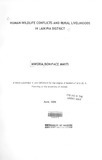| dc.description.abstract | There are increasing cases of conflicts between human beings and wildlife over the use of natural resources manifested through such incidents as people being killed or injured by wild animals; loss of livestock through predation; competition for pasture and water; invasion of crop farms and food stores by wildlife; inadequate or lack of compensation for losses or injuries; encroachment on wildlife areas such as forests and protected areas, blocking of wildlife migration routes; and poaching of wildlife for food, ivory, horns, skins and other valuable products. The economic and emotional costs of these conflicts can be quite enormous.
Interventions directed at reducing human-wildlife conflicts are any activities designed to reduce the severity or frequency of encounters between people and wild animals or any activity that increases peoples’ tolerance of wildlife. The effectiveness of interventions varies from region to region and also depends on the species involved. Barriers have been used as an intervention strategy for wildlife conservation and resolving human wildlife conflict and also to segregate the two users of resources. Electric fencing is the latest intervention in Kenya directed at alleviating conflicts between people and wildlife.
Until recently policy emphasis has been on the creation of barriers that kept wildlife from getting out of protected areas, the establishment of wildlife dispersal areas or keeping local people out of the wildlife areas. This study is an assessment of the effectiveness of these strategies by analyzing the effectiveness of different intervention measures on the livelihoods of smallholder farmers in Laikipia District in Kenya. The study was carried out in two areas: Endana and Rumuruti. The focus was on the effects of the strategies on the livelihoods of households in smallholder settlements in Laikipia and the livelihood strategies or coping mechanisms used in dealing with the conflict.
Elephants, baboons and bush pigs were the most problematic animals before the construction of barriers in the two areas. Other animals involved I the conflict were zebras, buffaloes, gazelles, hyenas and lions. The conflict was manifested through crop raiding, competition for resources, damage to crops and infrastructure, predation on livestock and threats to life. The farmers used a variety of strategies to deal with human-wildlife conflicts before the construction of the physical barriers. These strategies included creation of artificial and vegetation barriers,
x
burning fires to keep wildlife away, guarding of the farms, making noise and shining torches to scare wildlife off the farms and throwing of spears and stones.
In terms of effectiveness, the fencing strategy was more effective in reducing human wildlife conflicts compared to the strategy of constructing a ditch to keep wildlife at bay. The effects of the barriers on the livelihoods of the local farmers were increased crop yields, improved security and harmony, release of labour from dealing with the wildlife menace to other productive activities, reduced dependence on relatives and the government for food and the diversification of crops and other activities.
The study recommends that a review of Kenya’s policy and legislative framework in regard to consumptive utilization be carried to facilitate the legal utilization of wildlife resources by communities living adjacent or within wildlife dispersal areas. It further recommends that people who suffer from losses to wildlife should benefit from the incomes derived from wildlife presence in their area. Structures should also be put in place to manage the payment of compensation to farmers who have suffered losses to wildlife. The wildlife authorities should also start paying compensation to farmers who have suffered crop losses and damage to infrastructure by wildlife. | en_US |



